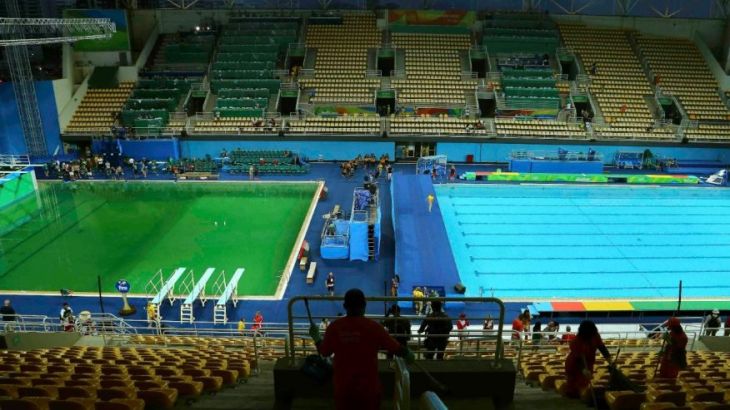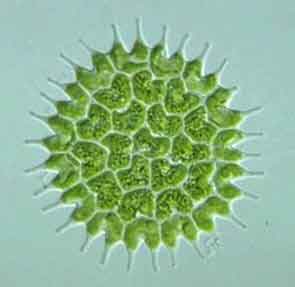How an accidental 160 litres of dechlorinating agent enabled green algae to thrive:
The green swimming pool has been one of the big mysteries of this year’s Rio Olympics. Why would one pool turn murky and green when the adjacent pool was still clear and blue?

Olympic pools at Rio this year, with one looking murky and green instead of clear and blue (image source)
The first official line from Olympic officials was that after extensive tests, they had finally pinpointed the reason to be a chemical imbalance caused by too many people using the water.
Mario Andrada, a Rio 2016 spokesman, said last Wednesday morning that “mid-afternoon, there was a sudden decrease in the alkalinity in the diving pool, and that’s the main reason the color changed,”
His interview with the NY Times stated that “He noted that a lot of people had been in the pools in the past week at the Maria Lenk Aquatic Center, and that their presence had touched off changes in the water’s chemical balance.”
The optimum pH for chlorinated pool water is 7.4, since this is the same as the pH in human eyes and mucous membranes and also gives good chlorine disinfection.
So could too many people in a pool make it more acidic?
Well the natural pH of skin is lower than chlorine at around 4.7 so his theory is plausible – too many people in a pool could have made it too acidic.
However, although I’m not a pool owner, I did spend my teens as a competitive swimmer in pools all over the world. No matter how busy they were, I’ve yet to see one turn green.
Also, you would think that seeing the Olympics is an invite only event, they would have had a heads up around how many people were coming and adjusted for that!
Perhaps it wasn’t just the presence of people in the pool, but what they did in there.
We all know from our childhood paint lessons that blue and yellow = green, so what if all of the Olympic swimmers not only swam but also peed in the pool?

We all know from our childhood paint lessons that blue and yellow = green, so what if all of the Olympic swimmers not only swam but also peed in the pool?
Well, with at least 3.73 million litres of water in the pool,and an average person peeing only 800 to 2,000 millilitres per day you would need at least 1 million people to pee their daily amount in the pool in one day to make any significant impact on the colour overnight. As there are only 11,000 Olympic athletes in total at the event, I also don’t think pool peeing was cause of the green hue.
Leaking bodily fluids into the pool does cause other issues due to an ammonia derivative called chloramine which forms from the interaction between the urine and chlorine mix. Chloramine however doesn’t usually have a habit of turning the water green, it just irritates the swimmers eyes on contact.

This is a man standing next to a 200 litre drum. 80 % of liquid from a drum this big seems like quite a lot of liquid to have been poured into the pool without noticing. (Image source)
 Algae spores and bacteria are constantly entering the pool, being brought in by wind or rain or on the skin or swimsuits of people in the pool.
Algae spores and bacteria are constantly entering the pool, being brought in by wind or rain or on the skin or swimsuits of people in the pool.So there you go, it looks like the acidic hydrogen peroxide altered the pool water pH while chemically undoing the job of the chlorine by acting as a dechlorinating agent resulting in a pool with perfect conditions for green algae to settle in to.